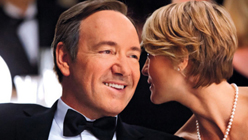The first season of House of Cards, a Netflix-original, Machiavellian political drama series, was released on February 1, 2013. In a little over a month the show has become the most streamed pieces of content in the country, according to Netflix. But with the internet already raving over the success of the show and Netflix frankly admitting to its pre-calculated popularity (essentially based on previous ratings of available Netflix videos) what is there left to talk about?
Well there’s what we watch, how we are watching it, and why. Short format vs. long format content is a big divider on the internet these days and Netflix seems to have made all the right moves for long-form viewing. Not only is House of Cards calculated to win as a political drama with its use of technology and self-referential narration, all topped with the well-loved Kevin Spacey, but Netflix specifically chose to release all 13 episodes of the first season all at once.

Unrestricted by weekly release schedules, this model means many viewers are devoting long weekends to watching the show in one go, a practice referred to as binge watching. This phenomenon isn’t new to streaming video; it dates back to well before television shows were even released on VHS, with über fans collecting recordings of their favorite TV shows on homemade tapes. While eventually whole seasons were released on VHS it wasn’t until soon after the invention of DVDs in 1995 that buying whole seasons of a show became mainstream practice. Buffy the Vampire Slayer was watched by many not during its ‘theatrical release’ but well after the show was no longer on television. Fans could be found binge watching season after season on DVD.
Netflix CEO Reed Hastings says viewers prefer this more novelistic approach saying, “We think the season is like the book.” With novels the reader can control the speed at which they read the content, and while many readers are happy to keep books to a leisurely pace, series like Harry Potter or Game of Thrones can get readers in a frenzy, tearing through book after book to reach the end (i.e. binge reading).




